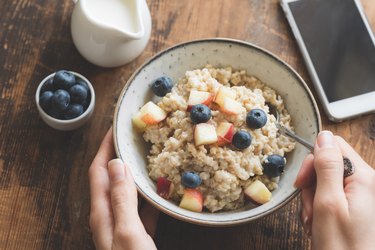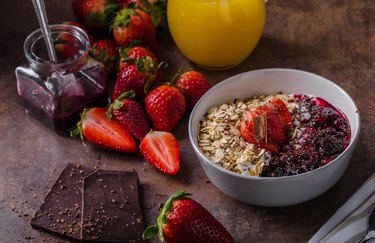
If you're trying to lose weight, you may have heard that eating oatmeal for breakfast can boost your metabolism. The obvious next question, then, is how much should you be eating to reap the benefits?
First, keep in mind that there's no single food item that can rev up your calorie-burning capacity — a healthy metabolism comes from an overall healthy lifestyle, which includes your eating, sleeping, exercise and stress-management habits.
Video of the Day
Video of the Day
But oats are right up there with the foods you should be eating regularly since they're loaded with good-for-you fiber and have a pretty impressive protein content for a whole grain.
Here's what to know about oatmeal for weight loss, including the right serving size and the healthiest way to eat this breakfast staple.
3 Types of Oats and Their Serving Sizes
When eating oatmeal for breakfast on your weight-loss plan, make sure to stick to appropriate serving sizes, which differ based on the type of oats:
Rolled Oats
- Serving size: 1/2 cup dry
- Calories: 150
- Fiber: 4 grams
Rolled oats are arguably the easiest to find and the most versatile. With only 150 calories and a good amount of fiber, these are a great choice for breakfast or a snack.
To make oatmeal from rolled oats, simply add in 1 cup of hot water or milk (water being the lower-calorie option).
The toppings are where you might get into trouble. Be careful how many sweeteners (honey, maple syrup, brown sugar) you add in, or you might reach the added sugar amount in some cereals. Stick with dried fruits and nuts if you can, which will keep your calories in check and offer more nutritional benefits.
Steel-Cut Oats
- Serving size: 1/4 cup dry
- Calories: 170
- Fiber: 4 grams
Also known as pinhead oats or Irish oats, steel-cut oats are the same oats used to make porridge. Steel-cut oats are still whole-grain oats but processed in a different way that ups their fiber content, which makes them slightly better for weight loss. They are toasted and cut using a steel blade, whereas rolled oats are steamed and flattened.
To make steel-cut oatmeal, add 3/4 cup hot water or milk to 1/4 cup dry oats. They take a little bit longer to cook than rolled oats, but that makes them the perfect choice for overnight oats or slow-cooker oats.
Quick-Cooking Oats
- Serving size: 1/2 cup dry
- Calories: 150
- Fiber: 4 grams
These are the types of oats you will see in packets, or you can buy a big container of quick-cooking oats on their own. You can make quick-cooking oatmeal the same way as old-fashioned oats — by mixing a half cup with 1 cup of hot water or milk — but the cooking time is decreased significantly, to approximately 1 minute.
If you're minding your calories, opt for plain quick-cooking oats rather than the flavored kind to avoid adding unnecessary calories and sugar to your breakfast.
Cheat Sheet for Cooking Oatmeal
Rolled Oats | Steel-Cut Oats | Quick Oats | |
Serving size | 1/2 cup | 1/4 cup | 1/2 cup |
Water or Milk | 1 cup | 3/4 cup | 1 cup |
Microwave Directions | Add water or milk and oats to a microwave-safe bowl and microwave on high for 2.5 to 3 minutes. | For microwave cooking, increase oats to 1/2 cup and water to 2 cups. Put in a large, 2-quart dish (because it will bubble up) and microwave for 5 minutes covered and 5 minutes uncovered. | Add water or milk and oats to a microwave-safe bowl and microwave on high or 90 seconds to 2 minutes. |
Stovetop Directions | Bring water or milk to a boil, stir in oats, turn heat down to medium and cook oats for 5 minutes. | Bring water or milk to a boil, stir in oats, turn heat to medium and cook oats for 15-20 minutes. | Bring water or milk to a boil, stir in oats, turn heat to medium and cook oats for 1 minute. |
Why Are Oats So Good for Your Metabolism?
Regardless of the type of oats you choose, they are all good for your health. They all contain roughly the same amount of fiber, protein and B vitamins, all of which carry health benefits for your weight-loss diet. Much of your decision might depend on how much time you have to cook your oats.
1. Fiber Is Beneficial for Weight Control
Oats are a good source of fiber, especially a type of fiber called beta-glucan, which is not digested in your body. Translation: The food moves more slowly through your digestive tract, helping you feel full longer and controlling your appetite, according to a January 2015 study in the Annals of Nutrition & Metabolism.
Higher fiber intake in general has also been shown to help with weight loss. According to an October 2019 study in the Journal of Nutrition, fiber, more than anything else, was able to help participants lose weight and maintain their diet.
Aim for the recommended daily amount of fiber — 25 grams for women and 38 grams for men, according to the Academy of Nutrition and Dietetics.
2. Protein Keeps You Feeling Full
Adding protein to your meals can help you stay full, and this can manage your hunger throughout the day (read: keep you out of the snack cabinet).
In fact, people who add protein to their first meal tend to eat less during the day, feel less hungry and better maintain their weight, according to a September 2015 study in Obesity.
Oats have 5 grams of protein per serving, according to the USDA. If you choose low-fat milk instead of water when cooking your oats, you can add another 6 to 8 grams of protein, per the USDA.
The recommended daily amount of protein is 0.8 grams per kilogram of body weight, according to Harvard Health Publishing. But if you're restricting calories to lose weight or actively building muscle through exercise, you should be getting more — closer to 1.3 grams per kilogram.
3. Oats Have B Vitamins
One serving of quick oats is going to give you 18 percent of your daily value of thiamin (vitamin B1), per the USDA. Whole grains in general are a good source of thiamin, which is essential for your metabolism to work properly, according to the National Institutes of Health.
There aren't any studies that can link thiamin to weight loss, but there are correlational studies to show that people who have obesity are also deficient in thiamin, according to a March 2015 article in Advances in Nutrition.
How to Amp Up Your Oats (the Healthy Way)
A packet of flavored instant oatmeal has about 2 to 3 teaspoons of added sugar, and too much added sugar can sabotage your weight-loss efforts. If that's something you're trying to limit, starting with plain oats is the way to go.
If you need a little sweetness, though, you can add your own sweeteners, such as honey or maple syrup, but these are also added sugars and high in calories, so use them sparingly.
There are ways to add natural sweetness without the added sugar. Try one of these ideas:
- Fresh berries
- Frozen fruit (mango, berries, cherries)
- Mashed ripe banana
- Dried fruit (stick with a quarter-cup serving)
- Blueberry Chia Jam
Other healthy add-ins for your oatmeal:
- Nuts (stick to a quarter-cup serving)
- Nut butter (a serving is 2 tablespoons)
- Flaxseed
- Chia seeds
- Unsweetened coconut

5 Healthy Oatmeal Breakfast Recipes to Try
If you need more ideas on how to add oatmeal to your everyday routine, here are five you might want to try:
- Cherry-Almond Steel Cut Oatmeal: Three grams of fiber and 10 grams of protein to keep you full all day.
- Dark Chocolate-Covered Strawberry Oatmeal: Six grams of fiber and 7 grams of protein shouldn't taste this good
- Chocolate Chip Cookie Dough Oatmeal: Almond butter spikes up the protein on this to give you 17 grams, plus 14 grams of fiber
- Greek Spinach and Feta Oatmeal: If savory is your thing, this recipe may get you hooked on steel-cut oats
- Peaches and Cream Steel Cut Oatmeal: There's no added sugar but a lot of sweetness in these overnight oats
- Journal of Food Science and Technology: "Nutritional advantages of oats and opportunities for its processing as value added foods - a review"
- Journal of Nutrition: "Fiber Intake Predicts Weight Loss and Dietary Adherence in Adults Consuming Calorie-Restricted Diets: The POUNDS Lost (Preventing Overweight Using Novel Dietary Strategies) Study."
- National Institutes of Health: "Thiamin"
- Advances in Nutrition: "Thiamin Deficiency in People with Obesity"
- USDA FoodData Central: "Oats"
- Obesity: "A High-Protein Breakfast Prevents Body Fat Gain, Through Reductions in Daily Intake and Hunger, In "Breakfast Skipping" Adolescents"
- Academy of Nutrition and Dietetics: "Fiber"
- Nutrition Journal: "The Role of Meal Viscosity and Oat β-glucan Characteristics in Human Appetite Control: A Randomized Crossover Trial"
- USDA FoodData Central: "Milk, low fat (1%)"
- Harvard Health Publishing: "How much protein do you need every day?"
- Annals of Nutrition & Metabolism: "Effects of oatmeal and corn flakes cereal breakfasts on satiety, gastric emptying, glucose, and appetite-related hormones"
Was this article helpful?
150 Characters Max
0/150
Thank you for sharing!
Thank you for your feedback!